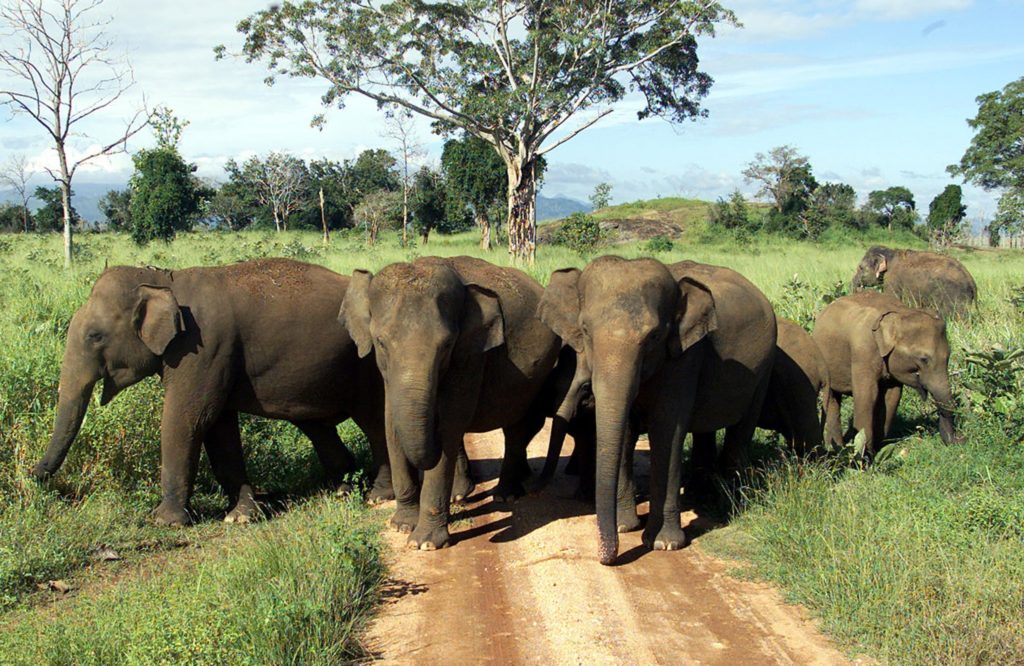Photo courtesy South China Morning Post
Killing elephants with shotguns is very inefficient. The clusters of tiny, iron pellets rarely kill such large animals instantly. Instead, pellets lodge in tissue and cartilage, causing wounds that ooze and fester for months before infection, then limited mobility and eventual starvation, kills the great aristocrats of Sri Lanka’s jungles. This long and painful penalty plays out, with the fallen elephant calling a final, heart-wrenching, childlike gulping, cry of distress.
Last week, the Government of Sri Lanka issued 2,000 shotguns to farmers in Human – Elephant Conflict (HEC) zones, to protect themselves and their crops from marauding elephants; a further, 3000 guns are to be issued shortly. Each year, as expanding farmland encroaches on elephant habitat, the HEC accounts for approximately 60 – 80 human and over 250 elephant lives. But, a petty politician’s baseless claim that the elephant population in the country is excessive, is neither legal nor adequate to license the shooting of elephants. The decision by the Department of Wildlife Conservation (DWC), mandated to protect the country’s wildlife, suggests an agenda that precludes conserving wildlife. What then? Votes at the next election, from the newest owners of shotguns, whose monthly income has ballooned with bush meat sales? The shotguns will surely be aimed at every living thing that moves in our wilderness, collapsing ecosystems, whilst the farmers await the arrival of the marauding elephant.
Tourism in Sri Lanka has just hit the very top line of global ratings — from the glamorous subscribers of Condé Naste Traveler, to the more intrepid traveler who scour Lonely Planet and Wanderlust, Sri Lanka, is now among the World’s 5 best destinations. Formerly known as Ceylon, by her colonial rulers, this mid-sized tropical island, 7º north of the equator, can offer everything a holiday describes: quiet beaches, archaeological wonders dating to pre-Christian eras, cool hotels and cafes with local cuisine that hits the perfect spot (between South Indian and Thai), while you sip the finest Ceylon tea or watch cultural pageants that cannot be found anywhere else on Earth… visit jungles and seas, teeming with wildlife, because Sri Lanka is a global Biodiversity Hotspot. But before purchasing a ticket to the paradise isle, today’s educated traveler will check the news, and soon discover that oddly, elephants, a big part of what draws them to Sri Lanka, are being killed throughout the island.
This decision by a Government is astounding for many reasons, but mostly for the extreme short-sightedness of licensing its citizens to kill or maim elephants. The world that is moving forward, towards environmental sustainability and Eco-Tourism, understands the tremendous value of easy sightings of wild elephants. At Minneriya, in central Sri Lanka, an annual migration of elephants allows one of the planet’s greatest wildlife experiences — ‘The Gathering’. Often, more than a thousand Asian elephants are to be seen, with families feeding, teenagers gambolling in the waters of the reservoir, outlying ‘loners’ skulking on the forest edges. ‘The Gathering’ generates, an estimate annual revenue of $7 million. Accordingly, island-wide elephant tourism garners an income that even the dimmest politicians cannot scoff at. And yet, a Government with the limited lens on farmer’s votes, issues guns to shoot wild elephants.
I wonder, will the wildlife enthusiasts of the world want to visit a Nation that is systematically killing her elephants? Will Sri Lanka, where magnificent elephants have now been demoted from National Treasure to vermin, be the paradise isle that modern tourists dream of? And the failed DWC — will it send its limited ranks of vets to treat the increasing number of elephants that will soon be shot by its own decree? This pitiable state can change with a word from one man — the new President of Sri Lanka. Now, we can only hope he will have the foresight to rein in his fatuous sycophants and withdraw the guns issued, to protect the true treasures of Sri Lanka – her wildlife.
